| Article ID | Journal | Published Year | Pages | File Type |
|---|---|---|---|---|
| 4991531 | Applied Thermal Engineering | 2017 | 8 Pages |
Abstract
The heat power dissipated by magnetic nanoparticles under alternating magnetic fields is a key parameter in biomedical applications like magnetic hyperthermia. The pulse-heating method determines the temperature increments undergone in adiabatic conditions by a specimen due to magnetic hyperthermia. The heat power can be accurately calculated from these increments provided that the heat capacity of the specimen is previously known. In this work, we highlight how this heat capacity, assumed to be the sum of the contributions of each specimen component, can present deviations due to several effects. Such deviations make necessary a systematic heat capacity determination for every specimen, which in turn requires adequate equipment and additional time. As an alternative, we present a new method that not only provides heat capacity data but also can be implemented in the same setup used for quantifying the temperature increments by the pulse-heating method in adiabatic conditions. Since this method determines the heat capacity during the time intervals between alternating magnetic field pulses, it allows to save characterization time and resources. Eventually, it provides higher accuracy: the heating power is obtained using just one specimen, one setup and one temperature-sweep measurement, avoiding error arising from the specimen composition or measuring conditions.
Related Topics
Physical Sciences and Engineering
Chemical Engineering
Fluid Flow and Transfer Processes
Authors
Eva Natividad, Irene Andreu,
